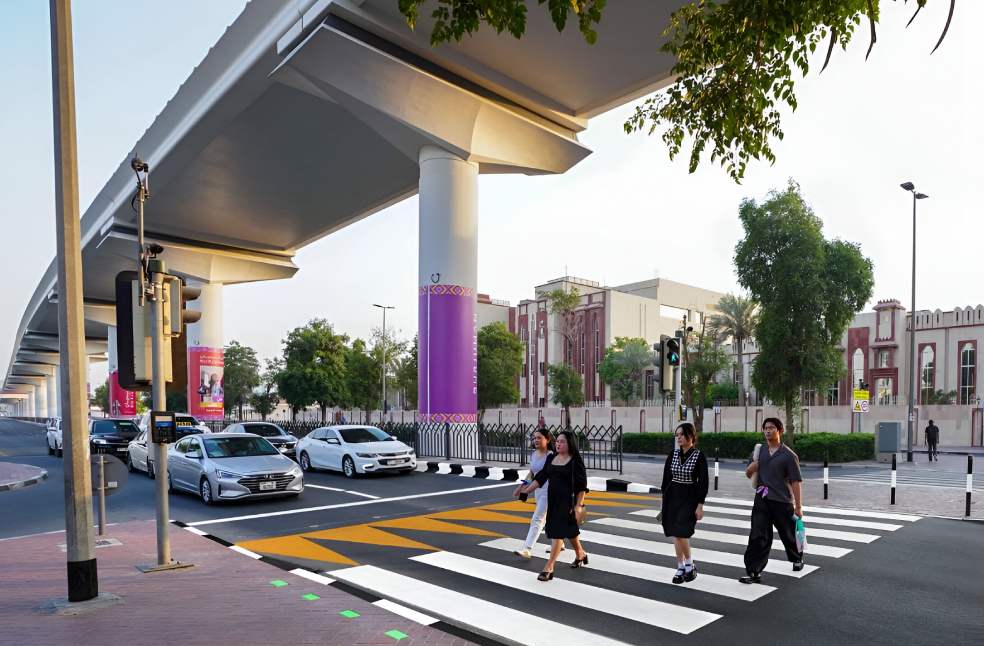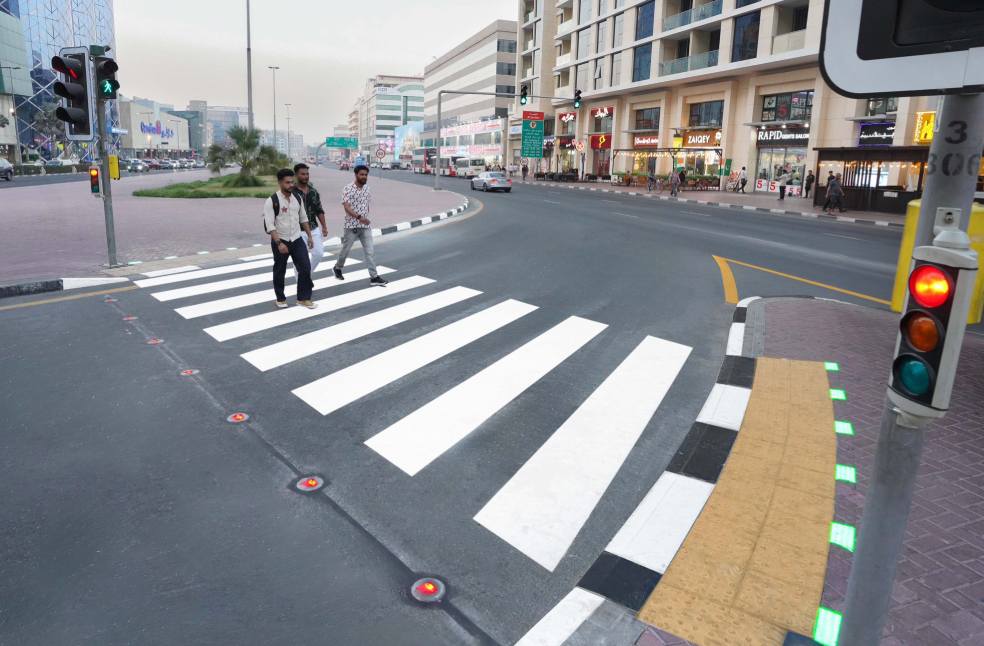Dubai continues to push the boundaries of urban innovation as the Roads and Transport Authority RTA proudly announces the completion of Phase Two of its Smart Pedestrian Signal Project. With the addition of 10 new intersections, a total of 27 strategic sites across the city are now equipped with intelligent pedestrian systems—transforming everyday street crossings into safer, smarter experiences for residents and visitors alike.
Next-Level Safety Through Smart Innovation
The latest phase marks a major milestone in the city’s journey toward building a pedestrian-friendly, technologically integrated mobility ecosystem. These smart pedestrian signals are not just basic timers or motion-activated lights—they are responsive, intuitive systems that automatically adapt to human movement and traffic conditions.
Using advanced sensors and thermal detection technology, the system monitors pedestrian activity in real-time. It adjusts crossing times depending on the number of people waiting and their walking speed, ensuring that everyone—from schoolchildren to senior citizens—has enough time to cross safely. Unlike traditional systems that operate on fixed cycles, these smart signals respond dynamically to actual foot traffic, significantly enhancing road safety and reducing unnecessary wait times for both pedestrians and vehicles.

How It Works: Tech That Feels Human
At the heart of the system lies an intelligent setup of thermal cameras and motion sensors, seamlessly embedded into traffic signal infrastructure. These sensors identify pedestrian presence without requiring any manual action like pressing a button. Once detected, the system evaluates factors like group size, walking pace, and crossing behavior to automatically adjust the green light duration for pedestrians.
This adaptive functionality is especially crucial in a city like Dubai, where streets often serve diverse groups of users, including tourists unfamiliar with local traffic patterns, families with children, people of determination, and elderly citizens who may need extra time.

With such smart systems in place, the days of hurried, dangerous dashes across wide avenues are numbered. The technology brings an empathetic layer to traffic management—one that anticipates human needs and adjusts accordingly.

Why These 27 Locations?
The selection of the 27 intersections now featuring the smart pedestrian signal system wasn’t random. Each site was identified through a careful evaluation process, which considered factors such as the volume of pedestrian traffic, accident history, proximity to schools and transit stations, and road width.
By focusing on high-risk and high-traffic areas, the RTA has ensured that this innovative system delivers maximum impact. Busy commercial zones, bustling urban crossings, and neighborhoods with vulnerable populations were prioritized, amplifying the value of every installation.
The result is a thoughtfully executed rollout that doesn’t just check boxes for innovation, but meaningfully improves daily life for thousands of people who walk Dubai’s streets every day.
Tangible Impact on Everyday Life
For pedestrians, the change is instantly noticeable. Waiting times are shorter during off-peak hours, and there’s greater confidence in the system’s responsiveness. People no longer feel rushed or neglected by a timer that fails to acknowledge their presence.
For drivers, the benefits are equally significant. By minimizing unnecessary signal changes caused by unused pedestrian crossings, traffic flow is smoother. The reduced start-stop motion means fewer delays, less fuel consumption, and lower emissions—supporting the city’s environmental goals as well.
Parents escorting children to school, tourists navigating unfamiliar crosswalks, delivery drivers, ride-hailing services—all segments of society experience a better, more seamless urban rhythm thanks to these upgrades.
Supporting Dubai’s Larger Vision
This initiative is part of Dubai’s comprehensive smart city strategy. The city has long been a pioneer in deploying emerging technologies across infrastructure, transportation, energy, and public services. The smart pedestrian signal project aligns perfectly with Dubai’s ambition to become one of the world’s most connected, AI-driven cities.
By incorporating intelligent systems into its urban fabric, Dubai is not just enhancing functionality—it is reimagining how cities should serve their people. From autonomous buses to AI-enabled parking systems, the city is building an ecosystem where infrastructure responds to human behavior in real time.
The smart pedestrian signals are a vital piece in this puzzle. They represent a shift from passive infrastructure to proactive, living systems—ones that read the environment and adapt in the moment.
What’s Next: Scaling Smarter Streets
Phase Two may be complete, but the journey doesn’t stop here. Dubai’s RTA has already laid out plans for expanding the project into Phase Three. This next phase will likely include additional intersections, more refined detection capabilities, and deeper integration with other smart city systems.
Future upgrades could involve linking pedestrian signals with real-time data from weather monitoring systems or integrating them with public transport schedules to reduce overall commuting time. Even vehicle-to-infrastructure communication may play a role—enabling cars to receive real-time updates from crosswalks, enhancing autonomous navigation systems and improving accident avoidance mechanisms.
Dubai’s future street will not just serve transportation; it will enable interaction between humans and machines in a frictionless flow of information and movement.
Human Stories from the Crosswalk
Beyond the technical achievements, it’s the human stories that truly bring this project to life.
A schoolteacher in Al Barsha, who crosses a busy street every morning with a group of young students, shared how much more confident she feels now. “Before the smart signals, I’d have to wait for long cycles and then rush the kids across the road. Now, the system actually seems to recognize that we’re a group and gives us enough time. It’s safer—and calmer.”
An elderly resident of Deira noted that she used to avoid going out during peak hours, fearing the chaos of fast-paced crossings. “Now I feel the city is taking care of us. It’s like someone is watching out for you.”
These testimonials underline a powerful truth: when infrastructure cares, people feel it. It’s not just technology—it’s empathy in engineering.
RTA’s Commitment to Inclusive Mobility
The Roads and Transport Authority has repeatedly affirmed its commitment to inclusive urban mobility. These smart pedestrian signals reflect that ethos. By adapting to different walking speeds and automatically detecting people of determination, the system ensures that no one is left behind in Dubai’s race toward innovation.
Children, seniors, those with disabilities—everyone benefits equally. And that’s exactly how a smart city should operate: not just faster, but fairer.
Creating a Culture of Safety
Alongside the infrastructure upgrade, RTA is also working on public awareness campaigns to help citizens understand and embrace the new system. Clear signage, educational videos, and outreach programs are being rolled out to ensure people know how to use the smart crossings effectively.

Creating a culture of safety requires more than just technology—it requires education, trust, and a shared sense of responsibility. By involving the community, RTA ensures that this isn’t just a top-down initiative but a collaborative evolution of how Dubai moves.
Environmental and Economic Benefits
Improved traffic flow doesn’t just benefit commuters—it also benefits the planet. Less idling time for vehicles means lower carbon emissions, improved fuel efficiency, and cleaner air in high-density zones. Over time, the compounded environmental benefits of smoother intersections can significantly contribute to the city’s sustainability targets.
Economically, the move boosts productivity. Fewer traffic delays mean time saved for thousands of workers, delivery operations, and public transport users. The cumulative time savings across the city’s population translate into real economic gains.
Final Thoughts: A City That Walks the Talk
Dubai has long been a city of bold statements and ambitious goals. But what sets it apart is its ability to translate vision into action. The Smart Pedestrian Signal Project is a perfect example of this ethos in motion.
What began as a concept is now a citywide reality, one intersection at a time. It’s not just a tale of technological success—it’s a story of thoughtful design, inclusivity, and a genuine commitment to making urban life better for everyone.
With 27 intersections now smarter than ever before, Dubai sends a clear message: safety, innovation, and humanity can walk hand in hand. And this is just the beginning.
Do follow UAE Stories on Instagram
Read More: From Ports to Policies: How Dubai Is Transforming Global Trade Forever














